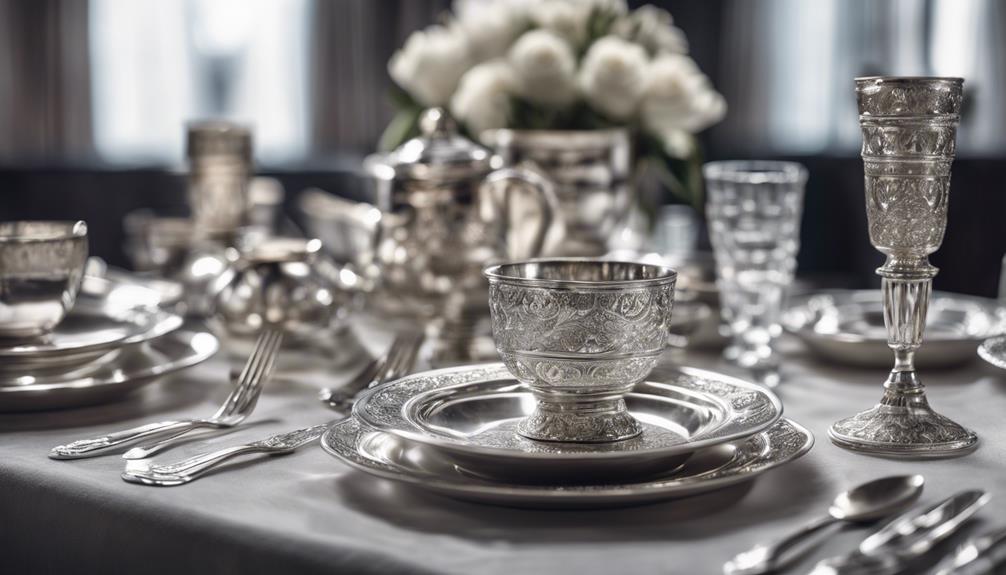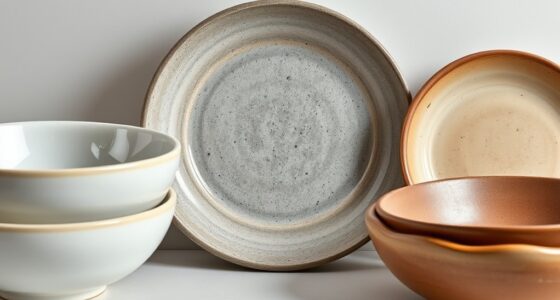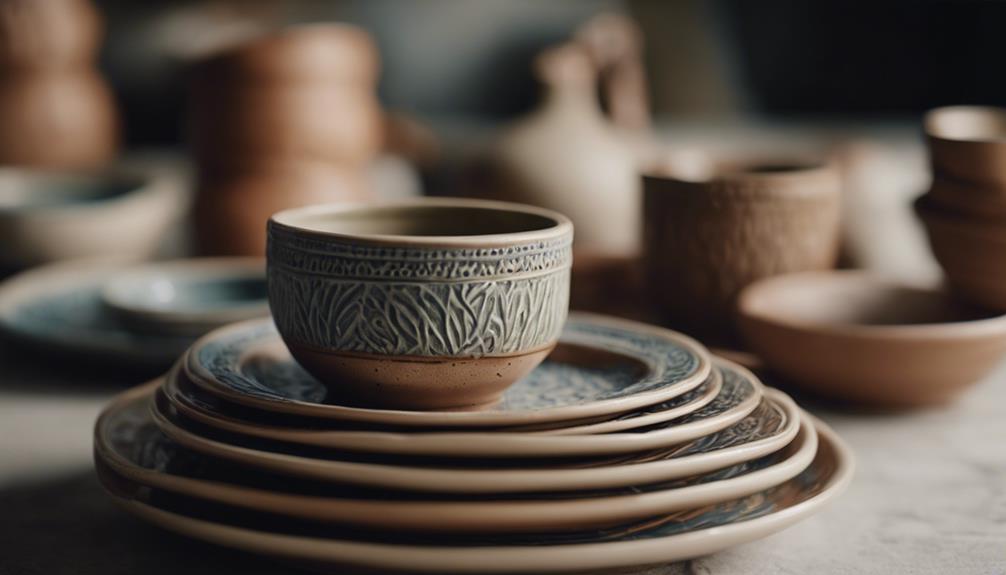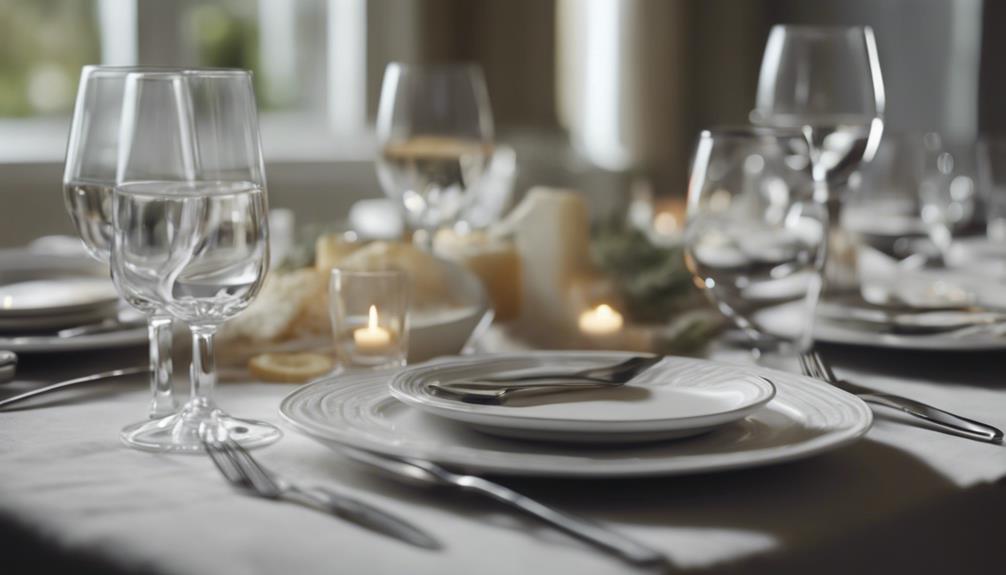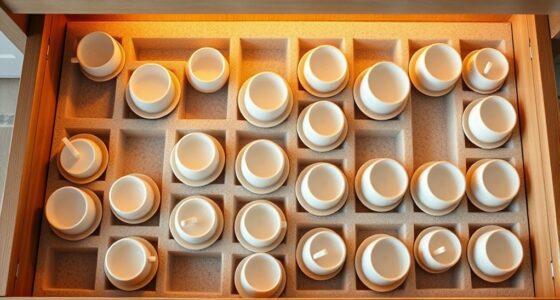In French, the term for tableware is ‘vaisselle.’ It includes dishes, utensils, and glassware necessary for setting a French table. Knowing ‘vaisselle’ increases cultural awareness and dining etiquette. It improves language skills and understanding of French traditions. ‘Vaisselle’ represents craftsmanship, French heritage, and regional influences. Various materials like porcelain, glass, and earthenware provide diverse choices. Setting a table in the French style highlights elegance, decor, and attention to detail. Renowned brands such as Bernardaud, Raynaud, and Gien exhibit fine dining customs. To find authentic French tableware, explore boutiques, online platforms, markets, and artisan fairs. Learn more about the different types of French tableware and customs.
Key Takeaways
- The French word for tableware is "vaisselle."
- "Vaisselle" includes dishes, utensils, and glassware.
- Knowing the French term enhances cultural knowledge.
- Understanding "vaisselle" deepens knowledge of French dining etiquette.
- Embracing "vaisselle" enriches language proficiency and cultural awareness.
The Significance of 'Vaisselle' in French Culture
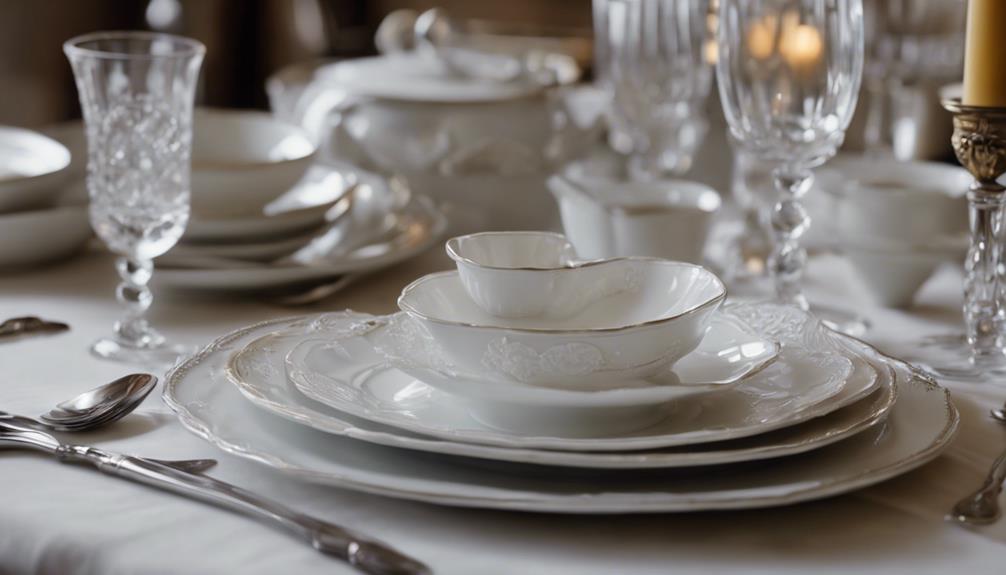
Understanding the term 'vaisselle' in French culture is essential for mastering the art of setting a proper table. In French, 'vaisselle' refers to the tableware, including dishes, utensils, and glassware used for dining. To truly explore the world of setting the table like the French, you must learn the French names for various tableware items such as 'une assiette' for plate and 'une serviette' for napkin. This knowledge isn't only beneficial for setting a beautiful table, but it also plays a significant role in enhancing your French language skills and cultural knowledge.
When you engage with the world of 'vaisselle', you open the door to a deeper understanding of French dining etiquette and traditions. By familiarizing yourself with the different elements that make up the 'vaisselle de la table', you not only elevate your table-setting skills but also gain insight into the importance of dining rituals in French culture. So, embrace the opportunity to learn about 'vaisselle' and enrich both your language proficiency and cultural awareness.
Materials Used in French Tableware
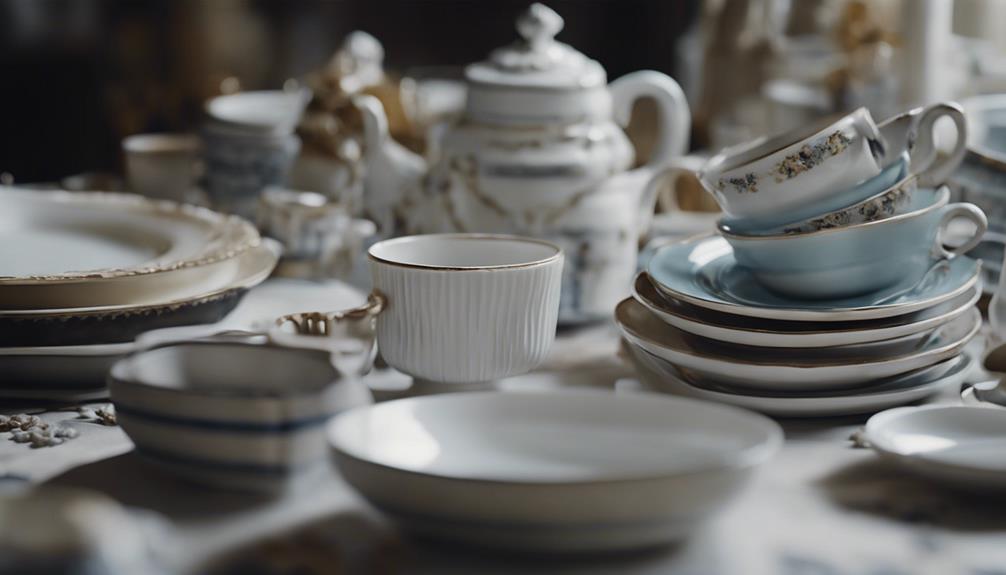
French tableware showcases a diverse range of materials, from delicate porcelain to rustic earthenware and fine pottery. Each material brings its own charm to the table, adding a unique touch to your dining experience. Here is a breakdown of the different materials used in French tableware:
| Material | Description | Features |
|---|---|---|
| Porcelain | Known for its delicate appearance and quality, porcelain tableware is perfect for elegant dining settings. | Lightweight, translucent, and often adorned with intricate designs. |
| Glass | French glass tableware comes in clear, colored, or opal glass, adding a touch of sophistication to the table. | Versatile, easy to clean, and can create stunning visual effects with various colors. |
| Earthenware | Ideal for everyday use, earthenware tableware is durable and exudes rustic charm, perfect for casual dining. | Sturdy, chip-resistant, and often features earthy tones and hand-painted designs. |
These materials offer a wide range of options to suit your table setting, whether you prefer elegance, rustic charm, or anything else.
Traditional French Tableware Styles

Amidst the rich tapestry of French culinary culture, traditional tableware styles stand as enduring symbols of artistry and refinement. The intricate designs and patterns found in traditional French tableware are often inspired by French heritage and craftsmanship, showcasing a deep appreciation for beauty and elegance. Classic French tableware sets typically include fine porcelain plates, elegant glassware, and ornate silverware, all contributing to a sophisticated and luxurious dining experience.
French tableware is known for its sense of sophistication and elegance, making it perfect for formal dining occasions where every detail matters. Traditional French table settings may include specific items such as soup tureens, gravy boats, and butter dishes, enhancing the overall dining experience with their practicality and charm. Additionally, French tableware designs can vary from region to region, highlighting the diverse cultural influences and culinary traditions that make France a hub of gastronomy and style.
How to Set a Table the French Way

To set a table the French way, start by mastering the table setting basics. French dining etiquette emphasizes using multiple glasses and cutlery for different courses.
Add an elegant touch with beautiful table decor to create a truly sophisticated dining experience.
Table Setting Basics
Set a charming table the French way by mastering the basics of table setting. When setting a French table, pay attention to the details to create an elegant dining experience. Here are a few key elements to take into account:
- Use multiple sets of plates: French table settings often involve layers of plates for different courses.
- Incorporate various tableware items: Include items like 'une assiette' (plate) and 'une soucoupe' (small plate for cups).
- Add different tablecloths: Using different tablecloths can add texture and depth to the table setting.
- Focus on precision and symmetry: Arrange items in a balanced and visually appealing manner to create a sophisticated look.
French Dining Etiquette
When preparing a French table according to dining etiquette, consider the arrangement of tableware as an essential element for a refined dining experience. In French dining etiquette, known as 'la vaisselle,' setting a pretty table is a common practice. Glasses are placed from tallest to smallest, sometimes up to seven in total. French households often have multiple sets of plates and tablecloths for various occasions. Understanding French table etiquette can enhance your dining experiences and social interactions. To help you visualize the proper table setting in a French dining scenario, here is an example:
| Plate Setting | Glassware | Cutlery |
|---|---|---|
| Dinner Plate | Water Goblet | Dinner Knife |
| Salad Plate | Red Wine Glass | Salad Fork |
| Bread Plate | White Wine Glass | Dinner Fork |
| Soup Bowl | Champagne Flute | Soup Spoon |
| Dessert Plate | Sherry Glass | Dessert Fork |
Elegant Table Decor
Arranging your table with meticulous attention to detail is key to creating an elegant French-inspired dining experience. To set a table the French way, consider the following:
- Place plates with precision, ensuring they're evenly spaced.
- Arrange cutlery in the traditional French style, with forks on the left and knives on the right.
- Use coordinated tableware sets for a sophisticated look that ties the elements together.
- Enhance the ambiance with fresh flowers, candles, and decorative napkins to elevate the elegance of your table setting.
Popular French Tableware Brands
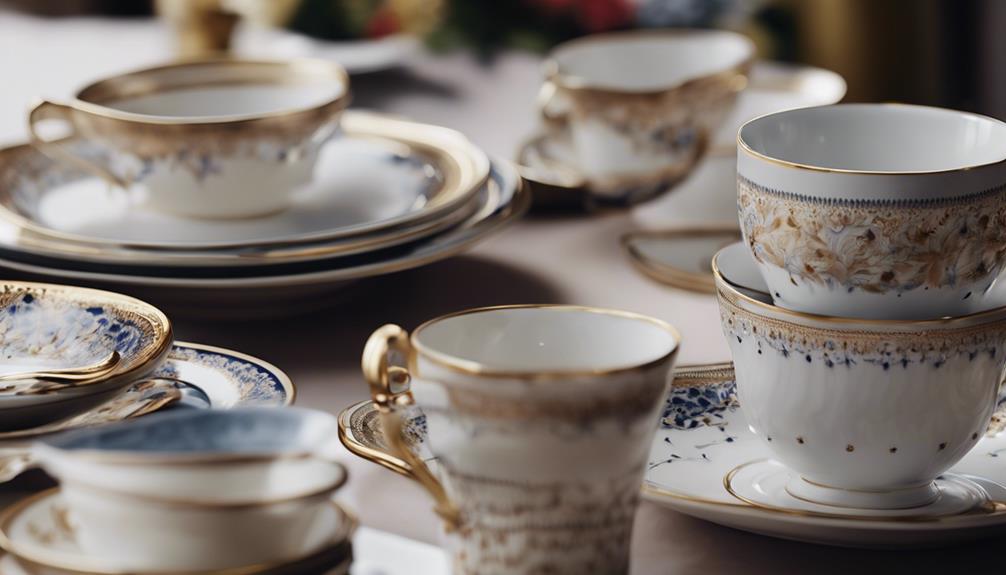
Renowned for their exquisite designs and high-quality craftsmanship, French tableware brands like Bernardaud, Raynaud, and Gien offer a wide range of elegant dining options. These brands are known for their attention to detail and the luxurious feel they bring to the dining table.
Bernardaud, a brand founded in 1863, is celebrated for its delicate porcelain pieces that blend tradition with modernity. Raynaud, with a history dating back to 1911, is recognized for its vibrant patterns and bold colors that add a pop of flair to any table setting. Gien, established in 1821, is famous for its faience earthenware that combines intricate designs with practical functionality.
Each of these brands carries a rich heritage in the art of fine dining, making them a popular choice for those seeking to elevate their dining experience with a touch of French sophistication.
French Tableware Etiquette and Customs
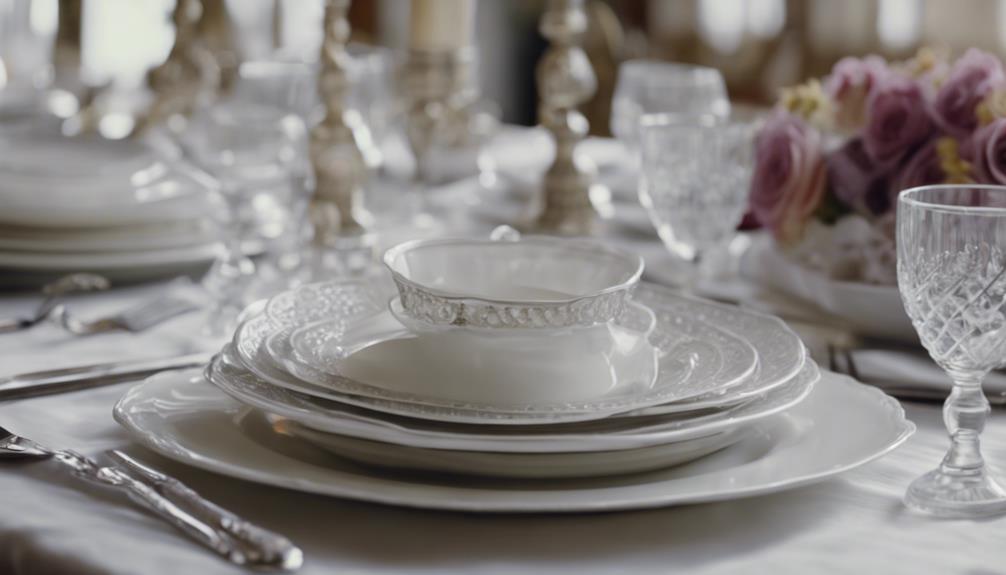
French tableware etiquette and customs emphasize the importance of setting a beautifully arranged table for every meal. Here are some key points to keep in mind:
- Multiple sets of plates and tablecloths are common in French households.
- Setting an elaborate table for special occasions is a customary practice in France.
- It's important not to confuse 'une assiette' (plate) with 'un siège' (chair).
- A small plate placed under a cup is known as 'une soucoupe' in French table settings.
In France, the presentation of a meal is considered an art form, and attention to detail is essential. Whether it's a casual family dinner or a festive gathering, taking the time to arrange the table thoughtfully is a sign of respect for both the food being served and the guests sharing the meal. So, next time you set the table, remember these etiquette tips to add a touch of French elegance to your dining experience.
Where to Find Authentic French Tableware
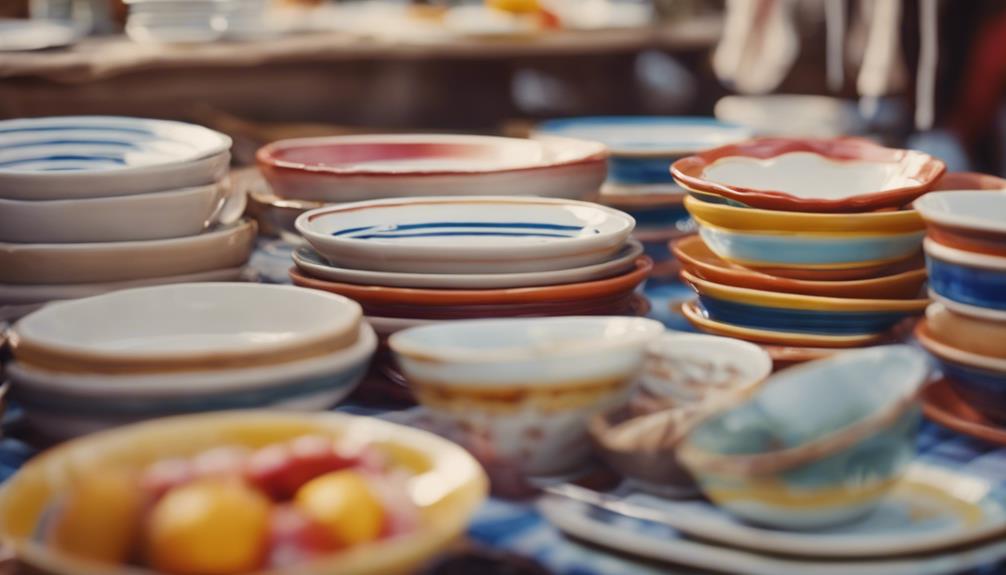
You can find authentic French tableware by exploring specialty boutiques and stores in France, where renowned brands like Gien, Bernardaud, and Limoges are often available.
Additionally, consider checking online platforms, such as French e-commerce websites and global retailers, for a selection of high-quality French tableware.
For unique and handmade pieces, visit local markets, artisan fairs, antique shops, or flea markets in France.
Authentic French Brands
When seeking out authentic French tableware, look to renowned brands such as Limoges, Gien, and Bernardaud for high-quality options crafted in France.
- Limoges: Known for elegant porcelain tableware, admired for its craftsmanship.
- Gien: Specializes in colorful and intricate faience earthenware designs.
- Bernardaud: Offers fine porcelain tableware favored by luxury hotels and restaurants worldwide.
Online Retailers
For authentic French tableware, explore online retailers specializing in French home goods and kitchenware. Platforms like Amazon, Williams-Sonoma, and Sur La Table offer a diverse range of French tableware options.
Dedicated websites such as FrenchTable.com and LaBoutiqueFrancaise.com curate traditional and contemporary French tableware collections. Look for renowned French brands like Le Creuset, Emile Henry, and Duralex when shopping online.
Detailed product descriptions, customer reviews, and shipping options are commonly provided by online retailers to assist you in selecting the perfect French tableware for your home. Whether you prefer classic designs or modern styles, these online retailers offer a convenient way to discover and purchase authentic French tableware without leaving the comfort of your home.
Frequently Asked Questions
What Is Another Name for Tableware?
Another name for tableware is 'vaisselle.' This term covers dishes, utensils, and glassware for setting a table.
Understanding 'vaisselle' is essential for discussing French table settings. It includes plates, bowls, cups, forks, and knives.
Learning 'vaisselle' expands vocabulary related to dining and table arrangements.
What Is the French Name for Dining Table?
The French term for a dining table is 'une table à manger.' It refers to the table where meals are served and tableware is placed.
Understanding this term can help you navigate French dining settings with ease. Knowing how to refer to key elements like 'une assiette' (plate) and 'une serviette' (napkin) enhances your dining etiquette.
Learning these French table setting terms enriches both your cultural understanding and language proficiency.
What Is the Term for Plates and Cutlery?
In French, 'une assiette' refers to plates, and 'les couverts' encompasses all types of cutlery. Understanding these terms is essential for setting the table correctly.
'La vaisselle' is the French term for tableware, encompassing plates and cutlery. Learning these words enhances your vocabulary related to dining and table settings.
Mastering these terms will help you navigate French dining experiences with ease and confidence.
What Are the French Names of Kitchen Equipment?
When it comes to French kitchen equipment, understanding the vocabulary is essential. Knowing the French names for various kitchen items is key for setting the table correctly. Mastering these terms is part of basic French language proficiency and can be helpful in language tests and everyday conversations.
Differentiating between 'une assiette' (plate) and 'une serviette' (napkin) is as vital as knowing your way around a kitchen. Keep practicing to enhance your skills in French table setting etiquette.
Conclusion
To sum up, 'vaisselle' is the French word for tableware, encompassing the cultural significance, materials used, styles, etiquette, and popular brands in France. By understanding the importance of tableware in French culture, one can appreciate the attention to detail and craftsmanship that goes into creating a beautiful table setting.
Whether enjoying a meal or hosting a gathering, the right tableware can elevate the dining experience and create a lasting impression.

